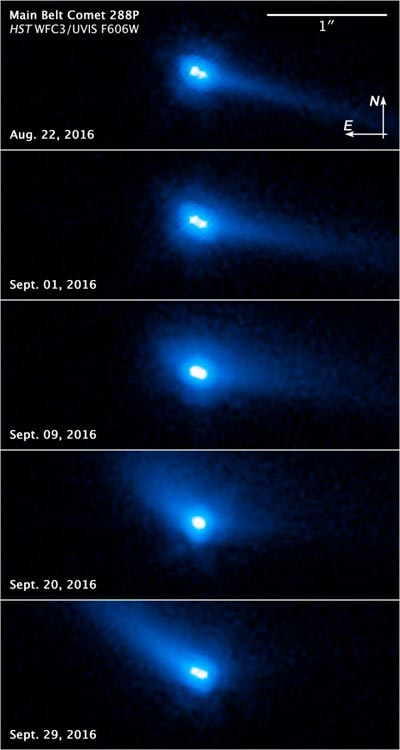
Hubble Unveils Unique Binary Asteroid Comet 300163 Discovery

Hubble photographed a pair of asteroids orbiting each other that have a tail of dust, which is a comet-like feature. The odd object, called 2006 VW139/288P, is the first known binary asteroid that is also classified as a main-belt comet. Roughly 5,000 years ago, 2006 VW139/288P probably broke into two pieces due to a fast rotation.
Credit: NASA, ESA, and J. Agarwal (Max Planck Institute for Solar System Research)
Asteroid 300163 (2006 VW139) was discovered by Spacewatch in November 2006 and then the possible cometary activity was seen in November 2011 by Pan-STARRS. Both Spacewatch and Pan-STARRS are asteroid survey projects of NASA's Near Earth Object Observations Program. After the Pan-STARRS observations it was also given a comet designation of 288P. This makes the object the first known binary asteroid that is also classified as a main-belt comet.
The more recent Hubble observations revealed ongoing activity in the binary system. “We detected strong indications for the sublimation of water ice due to the increased solar heating — similar to how the tail of a comet is created,” explained team leader Jessica Agarwal of the Max Planck Institute for Solar System Research, Germany.
The combined features of the binary asteroid — wide separation, near-equal component size, high eccentricity orbit, and comet-like activity — also make it unique among the few known binary asteroids that have a wide separation. Understanding its origin and evolution may provide new insights into the early days of the solar system. Main-belt comets may help to answer how water came to a bone-dry Earth billions of years ago.
The team estimates that 2006 VW139/288P has existed as a binary system only for about 5,000 years. The most probable formation scenario is a breakup due to fast rotation. After that, the two fragments may have been moved further apart by the effects of ice sublimation, which would give a tiny push to an asteroid in one direction as water molecules are ejected in the other direction.
The fact that 2006 VW139/288P is so different from all other known binary asteroids raises some questions about how common such systems are in the asteroid belt. “We need more theoretical and observational work, as well as more objects similar to this object, to find an answer to this question,” concluded Agarwal.
The research is presented in a paper, to be published in the journal Nature this week.
The Hubble Space Telescope is a project of international cooperation between NASA and ESA (European Space Agency). NASA's Goddard Space Flight Center in Greenbelt, Maryland, manages the telescope. The Space Telescope Science Institute (STScI) in Baltimore, Maryland, conducts Hubble science operations. STScI is operated for NASA by the Association of Universities for Research in Astronomy, Inc., in Washington, D.C.
For additional images, visit: http://hubblesite.
For more information about Hubble, visit: http://www.















